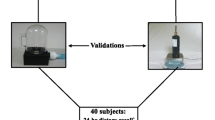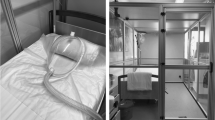Abstract
Purpose
This study describes methods to improve resting energy expenditure (REE) estimated by the indirect calorimetry by evaluating predictors for the achievement of steady-state conditions (SSC).
Methods
Cross-sectional study carried out with 20 women (30.2 ± 4.1 years; 27.8 ± 6.7 kg/m2). Indirect calorimetry was performed with the Quark RMR® calorimeter, during a 15-min period. VO2 consumption and VCO2 production were measured and data was collected every 5 s. Specific spreadsheet was used to compute the values of Steady REE and Software REE (deltaREE). Bias and concordance between values were assessed by the Bland-Altman plot and Lin’s correlation coefficient.
Results
There is an almost perfect concordance between Software REE and Steady REE (p = 0.001). Steady% was important for predicting deltaREE while variation of carbon dioxide exhaled (CVFECO2) was significant to predict Steady%. Also, CVFECO2 was strongly and significantly correlated with the CV of VO2 (r = 0.83, p = 0001) and with the CV of VCO2 (r = 0.9, p = 0001).
Conclusion
FECO2 should be sustained without huge variations to ensure SSC when using a calorimeter based on the canopy dilution technique with spontaneous breathing patients of similar characteristics. Also, these results suggest that since SSC occurs at least one time in the test, the Software REE may be considered reliable.

Similar content being viewed by others
Data availability
Raw data are available upon request from the corresponding author.
Abbreviations
- BLUPs:
-
best linear unbiased predictions
- BMI:
-
body mass index
- CVs:
-
coefficients of variation
- CVFECO2 :
-
variation of carbon dioxide exhaled
- FIO2 :
-
concentrations of oxygen inhaled
- FICO2 :
-
concentrations of carbon dioxide inhaled
- FEO2 :
-
concentrations of oxygen exhaled
- FECO2 :
-
concentrations of carbon dioxide exhaled
- IC:
-
indirect calorimetry
- REE:
-
resting energy expenditure
- SSC:
-
Steady-state conditions
- VCO2 :
-
amount (volume) of carbon dioxide released
- VO2 :
-
amount (volume) of oxygen used
References
Gupta RD, Ramachandran R, Venkatesan P, Anoop S, Joseph M, Thomas N. Indirect calorimetry: from bench to bedside. Indian J Endocrinol Metab. 2017;21(4):594–9.
Ferrannini E. The theoretical bases of indirect calorimetry: a review. Metabolism. 1988;37:287–01.
Weir JB. New methods for calculating metabolic rate with special reference to protein metabolism. J Physiol. 1949;109:1–9.
Oshima T, Graf S, Heidegger C, Genton L, Pugin J, Pichard C. Can calculation of energy expenditure based on CO2 measurements replace indirect calorimetry? Crit Care. 2017;21:13.
McClave SA, Spain DA, Skolnick JL, Lowen CC, Kieber MJ, Wickerham PS, et al. Achievement of steady state optimizes results when performing indirect calorimetry. JPEN J Parenter Enteral Nutr. 2003;27(1):16–20.
Borges JH, Langer RD, Cirolini VX, Pascoa MA, Guerra-Júnior G, Gonçalves EM. Minimum time to achieve the steady state and optimum abbreviated period to estimate the resting energy expenditure by indirect calorimetry in healthy young adults. Nutr Clin Pract. 2016;31(3):349e54.
Sanchez-Delgado G, Alcantara JMA, Ortiz-Alvarez L, Xu H, Martinez-Tellez B, Labayen I, et al. Reliability of resting metabolic rate measurements in young adults: impact of methods for data analysis. Clin Nutr. 2018;37(5):1618e24.
Cadena-Méndez M, Escalante-Ramírez B, Azpiroz-Leehan J, Infante-Vázquez O. VO2 and VCO2 variabilities through indirect calorimetry instrumentation. Springerplus. 2013;2:688.
Schutz Y. On problems of calculating energy expenditure and substrate utilization from respiratory exchange data. Z Ernahrungswiss. 1997;36(4):255–62.
Schutz Y Terminology, factors and constants in studies on energy metabolism of humans. In: Human energy metabolism: physical activity and energy expenditure measurements in epidemiological research based upon direct and indirect calorimetry. Van Es AJH (eds). EURO-NUT, report 5. Wageningen. 1985;153-I68.
Hanneman SK. Design, analysis, and interpretation of method-comparison studies. AACN Adv Crit Care. 2008;19:223–34.
Bland JM, Altman DG. Correlation, regression, and repeated data. BMJ. 1994;308:896.
Lin L. A concordance correlation coefficient to evaluate reproducibility. Biometrics. 1989;45:255–68.
West BT, Welch KB, Galecki AT, Gillespie BW. Linear mixed models: a practical guide using statistical software. Boca Raton: Chapman and Hall / CRC Press; 2006.
Blond E, Maitrepierre C, Normand S, Sothier M, Roth H, Goudable J, et al. A new indirect calorimeter is accurate and reliable for measuring basal energy expenditure, thermic effect of food and substrate oxidation in obese and healthy subjects. ESPEN J. 2011;6:e7–15.
Branson RD, Johannigman JA. The measurement of energy expenditure. Nutr Clin Pract. 2004;19(6):622–36.
Hamilton LC. Statistics with Stata, version 12. 8th ed. Belmont: Cengage; 2013.
Acknowledgments
Special thanks go to Neusa Aparecida Brasão Santos Carlos and Maria do Rosário Del Lama de Unamuno for all technical support and to Claire Helen Wardle Munhoz for checking the spelling of the text.
Funding
This study was supported by São Paulo Research Foundation (FAPESP) grants #2010/19821-6, #2012/03485-2, #2012/21579-4, and #2012/21626-2 and National Council for Scientific and Technological Development (CNPq) grant #306824/2006-0 and grant #425775/2016-0 Universal 01/2016.
Author information
Authors and Affiliations
Contributions
JHS, CMML, LWA, and JSM designed the research; JHS and CCML conducted the research; JHS, CFN, CFB, and KP analyzed data and wrote the initial draft of the manuscript; JHS had primary responsibility for final content. All authors contributed towards, and read and approved the final manuscript.
Corresponding author
Ethics declarations
Conflict of interest
The authors declare that they have no conflicts of interest.
Ethics approval
The research was conducted according to the Helsinki declaration, and the University’s ethical review board approved the study.
Consent to participate
Informed consent was obtained from all participants.
Consent for publication
Informed consent was obtained from all authors.
Code availability
Not applicable.
Supplementary information
Supplementary file 1
In this spreadsheet, each row starting at row 14, in columns A to F (in yellow), represents one of the five second measurements of the values of VO2, VCO2, VE, FEO2 and FECO2 recorded. Still starting at row 14, columns G to O (in gray) computed the means of each 5-min interval (i.e., between 5 min and 1 s to 10 min and 1 s; 5 min and 6 s to 10 min and 6 s and so forth). In row 9, from columns A to G (in blue), mean values of VO2, VCO2, Steady REE, RQ, FEO2, FECO2 and VE, obtained from the 60 possible intervals that are compatible with the SSC (SSC intervals), were computed. The columns H up to L, at row 9, showed the percentage of SSC intervals (Steady%) and if all Rest Phase were compatible with SSC’s definition. Row 6, columns N and O (in green) computed the CVs of VO2 and VCO2 from all the Rest Phase. Similarly, row 9, columns M to P, showed the mean values of VO2, VCO2, Software REE and coefficient of variation of the FECO2 (CVFECO2) from all the Rest Phase. Finally, in each test with at least one SSC interval, a deltaREE was calculated as the difference between Steady REE and Software REE. (PNG 979 kb)
Rights and permissions
About this article
Cite this article
Silvah, J.H., de Lima, C.M.M., Brandão, C.F. et al. Indirect calorimetry: best results with close monitoring of the carbon dioxide fraction in exhaled air. Nutrire 45, 26 (2020). https://doi.org/10.1186/s41110-020-00129-x
Received:
Accepted:
Published:
DOI: https://doi.org/10.1186/s41110-020-00129-x




